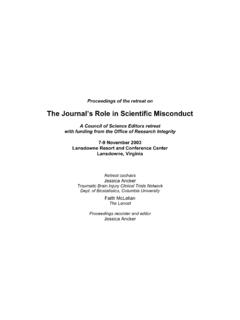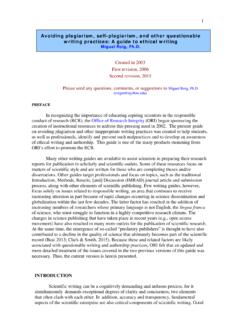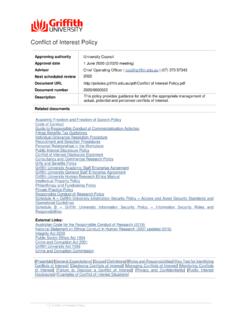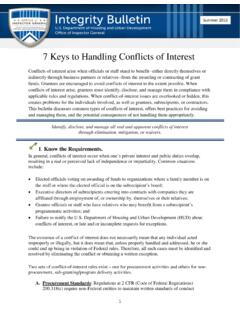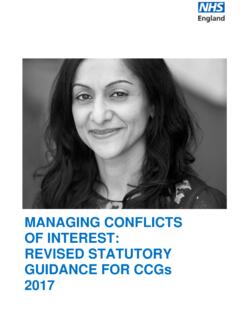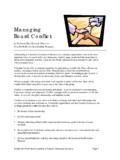Transcription of Chapter 4: CONFLICTS OF INTEREST (COI)
1 Chapter 4: CONFLICTS OF INTEREST (COI) A. Definitions INTEREST An INTEREST may be defined as a commitment, goal, or value held by an individual or an institution. Examples include a research project to be completed, gaining status through promotion or recognition, and protecting the environment. Interests are pursued in the setting of social interactions. Conflict of INTEREST (COI) A conflict of INTEREST exists when two or more contradictory interests relate to an activity by an individual or an institution. The conflict lies in the situation, not in any behavior or lack of behavior of the individual. That means that a conflict of INTEREST is not intrinsically a bad thing. Examples include a conflict between financial gain and meticulous completion and reporting of a research study or between responsibilities as an investigator and as a treating physician for the same trial participant. Institutional examples include the unbalancing of the institutional mission by acceding to the space requests of a large donor for an idiosyncratic program.
2 Other definitions include: CONFLICTS of INTEREST are situations in which financial or other personal considerations may compromise, or have the appearance of compromising, an investigator s judgement in conducting or reporting research. AAMC, 1990 A conflict of INTEREST in research exists when the individual has interests in the outcome of the research that may lead to a personal advantage and that might therefore, in actuality or appearance compromise the integrity of the research. NAS, Integrity in Scientific Research B. Consequences of a COI When an individual COI exists, then independent of the behavior of the investigator, those knowledgeable about the study must take the COI into account when judging the validity of the study. Beyond that, in clinical research, the well being of the subjects may also be compromised by a COI and this has become an overarching factor in the regulation of financial COIs in clinical research.
3 As noted above, the well being of the participants is paramount and trumps the completion of the research. C. Government intervention The Bayh-Dole act of 1980 made it possible for institutions and individuals to recover substantial financial rewards for their intellectual property as royalties and as equity. Furthermore, the reliance of research sponsors on the expertise of faculty to support a trial agent encouraged substantial payments to accrue to faculty as consultants, often on a continuing basis. Optimizing these financial interests produces a COI situation in relation both to the conduct of the research and to the welfare of trial subjects. Responding to these realities, the NIH, FDA and individual institutions developed rules for investigators to limit the impact of investigator COIs under Federal rules. A reminder follows The actual rules can be found at this URL The key provisions are, redacted: Investigators are required to disclose to an official(s) designated by the institution a listing of Significant Financial Interests (and those of his/her spouse and dependent children) that would reasonably appear to be affected by the research proposed for funding by the PHS.
4 The institutional official(s) will review those disclosures and determine whether any of the reported financial interests could directly and significantly affect the design, conduct, or reporting of the research and, if so, the institution must, prior to any expenditure of awarded funds, report the existence of such conflicting interests to the PHS Awarding Component and act to protect PHS-funded research from bias due to the conflict of INTEREST . The definition of "Significant Financial INTEREST " in has been changed in several respects. The exception for financial interests in business enterprises includes salary, royalties or other payments not reasonably expected to exceed $10,000 per annum. Alternative measures of $10,000 in value include stock or no more than five percent ownership INTEREST . In my view, $10,000 or an ownership position even if it has no cash value constitutes a significant COI and should be at least disclosed.
5 Disclosure requirements are very poor in that the statute limits them to the institutional administrators and the COI committee. They should be required to disclose every time they present or publish research. D. Industry Sponsorship Studies of industry sponsorship reveal profound influence over study design, analysis and interpretation of data (bias). They also engage in suppression of results (negative, AEs). They promulgate secrecy among researchers by negotiating confidentiality clauses in contracts. Sometimes results are made public while bypassing the peer review system. DDrruugg ccoommppaannyy mmoonneeyy aanndd iinnvveessttiiggaattoorr CCOOIIss hhaavvee ssoo ccoorrrruupptteedd cclliinniiccaall ttrriiaallss rreesseeaarrcchh tthhaatt ddrruugg ccoommppaanniieess ccoonnttrrooll wwhhaatt cclliinniicciiaannss aanndd ppaattiieennttss kknnooww aanndd ddoonn tt kknnooww aabboouutt tthhee $$220000,,000000,,000000 wwoorrtthh ooff ddrruuggss aanndd ddeevviicceess tthheeyy aarree TThhiiss iiss aallll aabboouutt bbyyppaassssiinngg MMeeddiicciinnee iiss bbeeccoommiinngg aa ssoorrtt ooff CClloouudd CCuucckkoooo LLaanndd,, wwhheerree ddooccttoorrss ddoonn tt kknnooww wwhhaatt ppaappeerrss tthheeyy ccaann ttrruusstt iinn tthhee DDrruummmmoonndd RReennnniiee ooff JJAAMMAA E.
6 Professional Societies Professional societies take huge amounts of pharmaceutical money to support their annual meetings and other activities. The funding may unbalance the science presented at the meeting. They permit highly biased Continuing Medical Education segments. Professional societies do not carefully control the listing of COIs in the scientific presentations. They foster over-the top media presentations of advances. They permit biased articles and supplements in their journals. F. Clinical Practice Guidelines The practice of evidence based medicine has led to the development of guideline for the treatment for many medical conditions, based on meetings of experts, often from professional societies. Treatment guidelines generally support the use of more procedures and medications. It was recently shown that 33% of guideline authors have financial interests in the drug 50% guidelines had no COI documentation 34% of guidelines stated no COIs 50% had at least one author receiving research support 43% had at least one author who had been a paid speaker for the company Derived from National Guideline Database Nature, Oct 20,2005 G.
7 Other initiatives The people who need to know about the COI are those who learn about the results of a study and have to interpret it. The decision about disclosure of a COI should never be left to the possessors of the COI because they are susceptible to self-deception or worse about the influence of the COI on their research behavior. Thus, NIH and other funding agencies, Professional Societies sponsoring research meetings, and the leading journals now require disclosure of COIs as a precondition for reviewing, editing, presenting and publishing research and research proposals but there is no means of enforcing the requirement. Voluntary revelation of a COI precludes the reviewing, of a grant or paper. A COI must be disclosed in presenting science. The Appearance of a COI must be avoided or disclosed. Consider the NY Times test. Would you want the relationship published in the NY Times? The presence of CONFLICTS of INTEREST tends to diminish the credibility of a study.
8 The most common CONFLICTS of INTEREST in research are between financial or career rewards and the integrity of a research study, report, presentation, or review. It s necessary to manage outside income, for consultations for lectures, for courses, for research when conducting a clinical trial. Full disclosure of CONFLICTS of INTEREST should be required in consent forms, papers, lectures and presentations. COIs may result in: 1. Loss of objectivity 2. Reordering of priorities towards applied research 3. Degradation of the nature of science as an open and collegial enterprise 4. Exploitation of trainees 5. Transfer of time and INTEREST to Commercial ventures H. COIs in Financial Consulting A new kind of COI has just come to light as the practice has become much more widespread through investigative reporting of the Seattle Times. Many investigators are recruited to consult for financial entities including venture capital firms, hedge funds and investment houses to inform them of the latest developments in their field.
9 The pay is good and the investigators feel quite flattered. Sometimes, the investigators have provided privileged information about an ongoing clinical trial about which both they and their institutions signed confidentiality statements. In all instances, the goal of the consulting groups is to learn information of investment value before the competition. After the initial concern, apparently this area of concern has lost immediacy. Cases: Chapter 4 Case: Remembra Dr. Zhivago, in NIH supported research, made remarkable progress in memory studies by identifying a new receptor C responsible for instilling and preserving memories. In mice and rats substantial improvements in memory were produced in a short time as demonstrated by performance studies. Activating C in monkeys permitted substantial acceleration in achieving cognitive skills and great enhancement in cognitive capability. Zhivago approached her institution s Office of Technology to arrange for patent and licensing.
10 The University had just established a research incubator to carry its inventions to a more advanced stage so that it would be able to retain a greater portion of the financial benefits to come from the products of discovery. The Office of Technology suggested that Zhivago establish a company with the university to exploit her discovery and develop small molecule receptor agonists for use in treating certain forms of mental retardation as well as Alzheimer s and other disorders. Neither Zhivago, nor the university officials were unaware of the fact that once approved, the agonists would most likely be taken by normal persons to augment their intellectual capabilities. Zhivago was told that the university would advance up to 1 million dollars of its endowment on this company and that as funding requirements grew, depending on the situation, either more new funds would be allocated or venture capitalists would be invited to invest.


